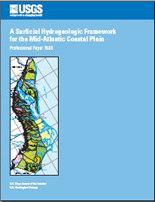 |
|
|
||||
| PUBLICATIONS—Professional Paper 1680 |
 |
A Surficial Hydrogeologic Framework for the Mid-Atlantic Coastal Plain |
A surficial hydrogeologic framework was developed for the Mid-Atlantic Coastal Plain, from New Jersey through North Carolina. The framework includes seven distinct hydrogeologic subregions within which the primary natural physical factors affecting the flow and chemistry of shallow ground water and small streams are relatively consistent. Within most subregions, the transport of chemicals from the land surface to ground water and streams can be described by a fairly uniform set of natural processes; some subregions include mixed hydrogeologic settings that are indistinguishable at the regional scale. The hydrogeologic framework and accompanying physiographic and geologic delineations are presented in digital and printed format.
The seven hydrogeologic subregions that constitute the framework were delineated primarily on the basis of physiography and the predominant texture (typical grain size) of surficial and (where surficial sediments are particularly thin) subcropping sediments. Physiography for the Mid-Atlantic Coastal Plain was constructed by standardizing and extrapolating previously published interpretations for the Coastal Plain of South Carolina and New Jersey, based on similar work in the other States. Surficial and subcropping geology were similarly compiled from previous publications by resolving inconsistencies in nomenclature, interpretation, and scale, and interpolating across unmapped areas. A bulk sediment texture was determined for each mapped geologic unit on the basis of published descriptions.
Fundamental differences among the seven hydrogeologic subregions are described on the basis of hypotheses about surficial and shallow subsurface hydrology and water chemistry in each, as well as variable land use, soils, and topography. On the regional scale, the Coastal Lowlands (Subregion 1), the Middle Coastal Plain – Fine Sediments (Subregion 3), the Middle Coastal Plain – Sands with Overlying Gravels (Subregion 4), and the Inner Coastal Plain – Upland Sands and Gravels (Subregion 5) are relatively homogeneous in terms of hydrogeology, although an examination of results from smallscale studies within the Coastal Plain demonstrates that even these areas are quite variable, locally. Moderate topographic relief and primarily permeable surficial sediments promote good drainage of the land surface in Subregion 4, for example, but drainage is commonly poor in the Coastal Lowlands (Subregion 1) due to flat topography and low elevations. Agriculture is common in both subregions, although artificial drainage is typically required to support cultivation in Subregion 1. Important physiographic differences are evident among the remaining three subregions, although sediment textures within the Middle Coastal Plain – Mixed Sediment Texture (Subregion 2), the Inner Coastal Plain – Dissected Outcrop Belt (Subregion 6), and the Alluvial and Estuarine Valleys (Subregion 7) are variable even at the regional scale.
Foreword
Abstract
Introduction
Purpose of a hydrogeologic framework
Limitations of previous data for regional investigations
The Mid-Atlantic Coastal Plain
Acknowledgements
Development of the regional surficial hydrogeologic framework
Delineation of regional physiography
Delineation of regional geology
Delineation of hydrogeologic subregions
The regional surficial hydrogeologic framework
Subregion 1: Coastal Lowlands
Subregion 2: Middle Coastal Plain – Mixed Sediment Texture
Subregion 3: Middle Coastal Plain – Fine Sediments
Subregion 4: Middle Coastal Plain – Sands with Overlying Gravel
Subregion 5: Inner Coastal Plain – Upland Sands and Gravels
Subregion 6: Inner Coastal Plain – Dissected Outcrop Belt.
Subregion 7: Alluvial and Estuarine Valleys
Evaluation of the regional framework at the local scale
Subregion 1: Coastal Lowlands
Subregion 2: Middle Coastal Plain – Mixed Sediment Texture
Subregion 3: Middle Coastal Plain – Fine Sediments
Subregion 4: Middle Coastal Plain – Sands with Overlying Gravels
Subregion 5: Inner Coastal Plain – Upland Sands and Gravels
Subregion 6: Inner Coastal Plain – Dissected Outcrop Belt
Subregion 7: Alluvial and Estuarine Valleys
Framework application
Intended uses
Limitations
Summary
References
Appendix 1: Technical notes
by Sarah K. MartucciAppendix 2: Geologic setting of the Mid-Atlantic Coastal Plain
by David E. KrantzThis report is available online in Portable Document Format (PDF). If you do not have the Adobe Acrobat PDF Reader, it is available for free download from Adobe Systems Incorporated.
Complete Accessible text of report (PDF, 3.6 MB)
Cover and outside page (PDF, 1.3 MB)
PLATES
Plates 1–4. Maps showing:
1. Physiography of the Mid-Atlantic Coastal Plain (PDF, 2.9 MB)
2. Surficial and subcropping geology of the Mid-Atlantic Coastal Plain (PDF, 7.7 MB)
3. Predominant texture of surficial geologic units in the Mid-Atlantic Coastal Plain (PDF, 3.4 MB)
4. Hydrogeologic subregions of the Mid-Atlantic Coastal Plain (PDF, 2.9 MB)
Document Accessibility: Adobe Systems Incorporated has information about PDFs and the visually impaired. This information provides tools to help make PDF files accessible. These tools convert Adobe PDF documents into HTML or ASCII text, which then can be read by a number of common screen-reading programs that synthesize text as audible speech. In addition, an accessible version of Acrobat Reader 5.0 for Windows (English only), which contains support for screen readers, is available. These tools and the accessible reader may be obtained free from Adobe at Adobe Access.
| AccessibilityFOIAPrivacyPolicies and Notices | |
 |
|